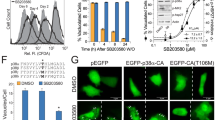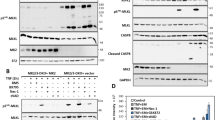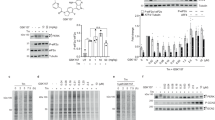Abstract
The anti-apoptotic Akt kinase is commonly activated by survival factors following plasma membrane relocalization attributable to the interaction of its pleckstrin homology (PH) domain with phosphatidylinositol 3-kinase (PI3K)-generated PI3,4-P2 and PI3,4,5-P3. Once activated, Akt can prevent or delay apoptosis by phosphorylation-dependent inhibition or activation of multiple signaling molecules involved in apoptosis, such as BAD, caspase-9, GSK3, and NF-κB and forkhead family transcription factors. Here, we describe and characterize a novel, conditional Akt controlled by chemically induced dimerization (CID). In this approach, the Akt PH domain has been replaced with the rapamycin (and FK506)-binding domain, FKBP12, to make F3-ΔPH.Akt. To effect membrane recruitment, a myristoylated rapamycin-binding domain from FRAP/mTOR, called M-FRB, binds to lipid permeable rapamycin (and non-bioactive synthetic ‘rapalogs’), leading to reversible heterodimerization of M-FRB with FKBP-ΔPH.Akt. Like endogenous c-Akt, we show that the kinase activity of membrane-localized F3-ΔPH.Akt correlates strongly with phosphorylation at T308 and S473; however, unlike c-Akt, phosphorylation and activation of inducible Akt (iAkt) is largely PI3K independent. CID-mediated activation of iAkt results in phosphorylation of GSK3, and contributes to NF-κB activation in vivo in a dose-sensitive manner. Finally, in Jurkat T cells stably expressing iAkt, CID-induced Akt activation rescued cells from apoptosis triggered by multiple apoptotic stimuli, including staurosporine, anti-Fas antibodies, PI3K inhibitors and the DNA damaging agent, etoposide. This novel inducible Akt should be useful for identifying new Akt substrates and for reversibly protecting tissue from apoptosis due to ischemic injury or immunological attack.
This is a preview of subscription content, access via your institution
Access options
Subscribe to this journal
Receive 12 print issues and online access
$259.00 per year
only $21.58 per issue
Buy this article
- Purchase on Springer Link
- Instant access to full article PDF
Prices may be subject to local taxes which are calculated during checkout








Similar content being viewed by others
References
Lander E.S. . Initial sequencing and analysis of the human genome Nature 2001 409: 860 860
Wymann M.P., Pirola L. . Structure and function of phosphoinositide 3-kinases Biochim Biophys Acta 1998 1436: 127 127
Chan T.O., Rittenhouse S.E., Tsichlis P.N. . AKT/PKB and other D3 phosphoinositide-regulated kinases: kinase activation by phosphoinositide-dependent phosphorylation Annu Rev Biochem 1999 68: 965 965
Bellacosa A., Testa J.R., Staal S.P., Tsichlis P.N. . A retroviral oncogene, akt, encoding a serine-threonine kinase containing an SH2-like region Science 1991 254: 274 274
Datta S.R., Brunet A., Greenberg M.E. . Cellular survival: a play in three Akts Genes Dev 1999 13: 2905 2905
Franke T.F. et al. The protein kinase encoded by the Akt proto-oncogene is a target of the PDGF-activated phosphatidylinositol 3-kinase Cell 1995 81: 727 727
Shaw M., Cohen P., Alessi D.R. . The activation of protein kinase B by H202 or heat shock is mediated by phosphoinositide 3-kinase and not by mitogen-activated protein kinase-activated protein kinase-2 Biochem J 1998 336: 241 241
Zhu W.Z. et al. Dual modulation of cell survival and cell death by beta(2)-adrenergic signaling in adult mouse cardiac myocytes Proc Natl Acad Sci USA 2001 98: 1607 1607
Kroner C., Eybrechts K., Akkerman J.W. . Dual regulation of platelet protein kinase B J Biol Chem 2000 275: 27790 27790
Filippa N. et al. Mechanism of protein kinase B activation by cyclic AMP-dependent protein kinase Mol Cell Biol 1999 19: 4989 4989
Balendran A. et al. PDK1 acquires PDK2 activity in the presence of a synthetic peptide derived from the carboxyl terminus of PRK2 Curr Biol 1999 9: 393 393
Toker A., Newton A.C. . Akt/protein kinase B is regulated by autophosphorylation at the hypothetical PDK-2 site J Biol Chem 2000 275: 8271 8271
Meier R., Thelen M., Hemmings B.A. . Inactivation and dephosphorylation of protein kinase Balpha (PKBalpha) promoted by hyperosmotic stress EMBO J 1998 17: 7294 7294
Nakatani K. et al. Up-regulation of Akt3 in estrogen receptor-deficient breast cancers and androgen-independent prostate cancer lines J Biol Chem 1999 274: 21528 21528
Yuan Z.Q. et al. Frequent activation of AKT2 and induction of apoptosis by inhibition of phosphoinositide-3-OH kinase/Akt pathway in human ovarian cancer Oncogene 2000 19: 2324 2324
Liu A.X. et al. AKT2, a member of the protein kinase B family, is activated by growth factors, v-Ha-ras, and v-src through phosphatidylinositol 3-kinase in human ovarian epithelial cancer cells Cancer Res 1998 58: 2973 2973
Stambolic V. et al. Negative regulation of PKB/Akt-dependent cell survival by the tumor suppressor PTEN Cell 1998 95: 29 29
Li J. et al. The PTEN/MMAC1 tumor suppressor induces cell death that is rescued by the AKT/protein kinase B oncogene Cancer Res 1998 58: 5667 5667
Cantley L., Neel B.G. . New insights into tumor suppression: PTEN suppresses tumor formation by restraining the phosphoinositide 3-kinase/AKT pathway Proc Natl Acad Sci USA 1999 96: 4240 4240
Cross D.A. et al. Inhibition of glycogen synthase kinase-3 by insulin mediated by protein kinase B Nature 1995 378: 785 785
Gossen M. et al. Transcriptional activation by tetracyclines in mammalian cells Science 1995 268: 1766 1766
Jackson P., Baltimore D., Picard D. . Hormone-conditional transformation by fusion proteins of c-Abl and its transforming variants EMBO J 1993 12: 2809 2809
Picard D. . Regulation of protein function through expression of chimaeric proteins Curr Opin Biotechnol 1994 5: 511 511
Samuels M.L., Weber M.J., Bishop J.M., McMahon M. . Conditional transformation of cells and rapid activation of the mitogen-activated protein kinase cascade by an estradiol-dependent human raf-1 protein kinase Mol Cell Biol 1993 13: 6241 6241
Spencer D.M., Wandless T.J., Schreiber S.L., Crabtree G.R. . Controlling signal transduction with synthetic ligands Science 1993 262: 1019 1019
Spencer D.M. . Creating conditional mutations in mammals Trends Genet 1996 12: 181 181
Spencer D.M. et al. Functional analysis of Fas signaling in vivo using synthetic inducers of dimerization Curr Biol 1996 6: 839 839
Blau C.A., Peterson K., Drachman J.G., Spencer D.M. . A proliferative switch for genetically modified cells Proc Natl Acad Sci USA 1997 94: 3076 3076
Luo Z. et al. Oligomerization activates c-Raf-1 through a Ras-dependent mechanism (see comments) Nature 1996 383: 181 181
MacCorkle R.A., Freeman K.W., Spencer D.M. . Synthetic activation of caspases: artificial death switches Proc Natl Acad Sci USA 1998 95: 3655 3655
Ho S.N. et al. Dimeric ligands define a role for transcriptional activation domains in reinitiation Nature 1996 382: 822 822
Rivera V.M. et al. A humanized system for pharmacologic control of gene expression Nat Med 1996 2: 1028 1028
Spencer D.M. et al. A general strategy for producing conditional alleles of Sre-like tyrosine kinases Proc Natl Acad Sci USA 1995 92: 9805 9805
Holsinger L.J. et al. Signal transduction in T lymphocytes using a conditional allele of Sos Proc Natl Acad Sci USA 1995 95: 9810 9810
Pollock R. et al. Delivery of a stringent dimerizer-regulated gene expression system in a single retroviral vector Proc Natl Acad Sci USA 2000 97: 13221 13221
Kohn A.D., Takeuchi F., Roth R.A. . Akt, a pleckstrin homology domain containing kinase, is activated primarily by phosphorylation J Biol Chem 1996 271: 21920 21920
Chen J., Zheng X.F., Brown E.J., Schreiber S.L. . Identification of an 11-kDa FKBP12-rapamycin-binding domain within the 289-kDa FKBP12-rapamycin-associated protein and characterization of a critical serine residue Proc Natl Acad Sci USA 1995 92: 4947 4947
Choi J., Chen J., Schreiber S.L., Clardy J. . Structure of the FKBP12-rapamycin complex interacting with the binding domain of human FRAP Science 1996 273: 239 239
Kane L.P., Shapiro V.S., Stokoe D., Weiss A. . Induction of NF-kappaB by the Akt/PKB kinase Curr Biol 1999 9: 601 601
Madrid L.V. et al. Akt suppresses apoptosis by stimulating the transactivation potential of the RelA/p65 subunit of NF-kappaB Mol Cell Biol 2000 20: 1626 1626
Madrid L.V., Mayo M.W., Reuther J.Y., Baldwin A.S. Jr. . Akt stimulates the transactivation potential of the RelA/p65 Subunit of NF-kappa B through utilization of the Ikappa B kinase and activation of the mitogen-activated protein kinase p38 J Biol Chem 2001 276: 18934 18934
Andjelkovic M. et al. Role of translocation in the activation and function of protein kinase B J Biol Chem 1997 272: 31515 31515
Alessi D.R. et al. 3-Phosphoinositide-dependent protein kinase-1 (PDK1): structural and functional homology with the Drosophila DSTPK61 kinase Curr Biol 1997 7: 776 776
Anderson K.E., Coadwell J., Stephens L.R., Hawkins P.T. . Translocation of PDK-1 to the plasma membrane is important in allowing PDK-1 to activate protein kinase B Curr Biol 1998 8: 684 684
Bellacosa A. et al. Akt activation by growth factors is a multiple-step process: the role of the PH domain Oncogene 1998 17: 313 313
Alessi D.R. et al. Characterization of a 3-phosphoinositide-dependent protein kinase which phosphorylates and activates protein kinase Balpha Curr Biol 1997 7: 261 261
Tamaoki T. et al. Staurosporine a potent inhibitor of phospholipid/Ca++-dependent protein kinase Biochem Biophys Res Commun 1986 135: 397 397
Secrist J.P., Sehgal I., Powis G., Abraham R.T. . Preferential inhibition of the platelet-derived growth factor receptor tyrosine kinase by staurosporine J Biol Chem 1990 265: 20394 20394
Rohn J.L. et al. The opposing roles of the Akt and c-Myc signalling pathways in survival from CD95-mediated apoptosis Oncogene 1998 17: 2811 2811
Hausler P. et al. Protection of CD95-mediated apoptosis by activation of phosphatidylinositide 3-kinase and protein kinase B Eur J Immunol 1998 28: 57 57
Kaufmann S.H. . Cell death induced by topoisomerase-targeted drugs: more questions than answers Biochim Biophys Acta 1998 1400: 195 195
Hemmings B.A. . Akt signaling: linking membrane events to life and death decisions Science 1997 275: 628 628
Crabtree G.R., Schreiber S.L. . Three-part inventions: intracellular signaling and induced proximity Trends Biochem Sci 1996 21: 418 418
Franke T.F., Kaplan D.R., Cantley L.C., Toker A. . Direct regulation of the Akt proto-oncogene product by phosphatidylinositol-3,4-bisphosphate Science 1997 275: 665 665
Kohn A.D. et al. Construction and characterization of a conditionally active version of the serine/threonine kinase Akt J Biol Chem 1998 273: 11937 11937
Liberles S.D., Diver S.T., Austin D.J., Schreiber S.L. . Inducible gene expression and protein translocation using nontoxic ligands identified by a mammalian three-hybrid screen Proc Natl Acad Sci USA 1997 94: 7825 7825
Mirza A.M., Kohn A.D., Roth R.A., McMahon M. . Oncogenic transformation of cells by a conditionally active form of the protein kinase Akt/PKB Cell Growth Differ 2000 11: 279 279
Bordignon C. et al. Transfer of the HSV-tk gene into donor peripheral blood lymphocytes for in vivo modulation of donor anti-tumor immunity after allogeneic bone marrow transplantation Hum Gene Ther 1995 6: 813 813
Thomis D.C. et al. A Fas-based suicide switch in human T cells for the treatment of graft-versus-host disease Blood 2001 97: 1249 1249
Thomis D.C. et al. A Fas-based suicide switch in human T cells for the treatment of graft-versus-host disease
Linnik MD, Zahos P, Geschwind MD, Federoff HJ. Expression of bcl-2 from a defective herpes simplex virus-1 vector limits neuronal death in focal cerebral ischemia. Stroke 1995; 26: 1670–1674; discussion 1675 J Cereb Blood Flow Metab 1997 17: 740 740
Antonawich F.J. et al, Federoff H.J. et al, Davis J.N. et al. BCL-2 transduction, using a herpes simplex virus amplicon, protects hippocampal neurons from transient global ischemia Exp Neurol 1999 156: 130 130
Shimazaki K. et al. Adeno-associated virus vector-mediated bcl-2 gene transfer into post-ischemic gerbil brain in vivo: prospects for gene therapy of ischemia-induced neuronal death Gene Therapy 2000 7: 1244 1244
Bilbao G. et al. Reduction of ischemia-reperfusion injury of the liver by in vivo adenovirus-mediated gene transfer of the antiapoptotic Bcl-2 gene Ann Surg 1999 230: 185 185
Matsui T. et al. Akt activation preserves cardiac function and prevents injury after transient cardiac ischemia in vivo Circulation 2001 104: 330 330
Lu Y. et al. Activated Akt protects the lung from oxidant-induced injury and delays death of mice J Exp Med 2001 193: 545 545
Zheng L. et al. Cytoprotection of human umbilical vein endothelial cells against apoptosis and CTL-mediated lysis provided by caspase-resistant Bcl-2 without alterations in growth or activation responses J Immunol 2000 164: 4665 4665
Bilbao G. et al. Genetic modification of liver grafts with an adenoviral vector encoding the Bcl-2 gene improves organ preservation Transplantation 1999 67: 775 775
Bilbao G. et al. Genetic cytoprotection of human endothelial cells during preservation time with an adenoviral vector encoding the anti-apoptotic human Bcl-2 gene Transplant Proc 1999 31: 1012 1012
Contreras J.L. et al. Gene transfer of the Bcl-2 gene confers cytoprotection to isolated adult porcine pancreatic islets exposed to xenoreactive antibodies and complement Surgery 2001 130: 166 166
Bellacosa A. et al. Structure, expression and chromosomal mapping of c-akt: relationship to v-akt and its implications Oncogene 1993 8: 745 745
Datta S.R. et al. Akt phosphorylation of BAD couples survival signals to the cell-intrinsic death machinery Cell 1997 91: 231 231
Lloyd R.E., Grubman M.J., Ehrenfeld E. . Relationship of p220 cleavage during picornavirus infection to 2A proteinase sequencing J Virol 1988 62: 4216 4216
Northrop J.P., Ullman K.S., Crabtree G.R. . Characterization of the nuclear and cytoplasmic components of the lymphoid-specific nuclear factor of activated T cells (NF-AT) complex J Biol Chem 1993 268: 2917 2917
Shan X. et al. Deficiency of PTEN in Jurkat T cells causes constitutive localization of Itk to the plasma membrane and hyperresponsiveness to CD3 stimulation Mol Cell Biol 2000 20: 6945 6945
Acknowledgements
We thank Gerald R Crabtree and Tim Clackson for a critical reading of the manuscript and M. Neiditch, S-H Lee, and E Lowenthal for technical assistance. We thank ARIAD Pharmaceuticals for generously providing AP22783 and the FRB1 template DNA, P Tsichlis for plasmid pCMV6-HA-Akt, M Greenberg for plasmid pCMV-HA-AktK179M, and R Lloyd for pTPOV-3816. This work was supported by NIH grants R01-CA87569 and U01-CA84296.
Author information
Authors and Affiliations
Rights and permissions
About this article
Cite this article
Li, B., Desai, S., MacCorkle-Chosnek, R. et al. A novel conditional Akt ‘survival switch’ reversibly protects cells from apoptosis. Gene Ther 9, 233–244 (2002). https://doi.org/10.1038/sj.gt.3301641
Received:
Accepted:
Published:
Issue Date:
DOI: https://doi.org/10.1038/sj.gt.3301641



